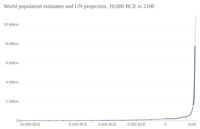
Photo from wikipedia
Abstract This study presents the calculated reference interval for the disc-to-macula distance to disc diameter ratio (DM:DD) based on a large population of healthy Japanese adults. A total of 308… Click to show full abstract
Abstract This study presents the calculated reference interval for the disc-to-macula distance to disc diameter ratio (DM:DD) based on a large population of healthy Japanese adults. A total of 308 consecutive, healthy Japanese adults were examined in this prospective observational study. Eighteen subjects were also excluded because of poor quality of the fundus photograph of one or both eyes; 290 (161 men and 129 women) were included in this study. For each subject, a color fundus photograph of one eye, either the right or left, was randomly selected and used for analysis. On the photograph, the distances between the fovea and the nearest temporal margin of the optic disc (Dft), and the two kinds of disc diameters (D1 and D2), which bisected at right angles and one of which was directed to the fovea (D1), were measured. DM:DD was estimated using the formula: (2Dft + D1)/(D1 + D2). The mean ± standard deviation of DM:DD was 2.91 ± 0.49 for men and 2.96 ± 0.54 for women; there was no sex difference (P = .78, Mann–Whitney U test). Also, almost no relationship was found between DM:DD and age (&rgr; = −.12, P = .04, Spearman's rank correlation coefficient). The data did not fit a normal distribution (P < .001, Kolmogorov–Smirnov test). The estimated reference interval for DM:DD corresponding to the 2.5th and 97.5th percentiles was 2.12 to 4.18. Using a nonparametric approach, the reference interval for DM:DD of a large population of healthy Japanese adults was calculated to be 2.12 to 4.18, regardless of age or sex.
Journal Title: Medicine
Year Published: 2017
Link to full text (if available)
Share on Social Media: Sign Up to like & get
recommendations!